Synth DIY Projects
Technical openness and excellent documentation are core values for North Coast, and this page gathers schematics, build guides with Bills Of Materials (BOMs), and other SDIY information for all our products. Click through to the product pages for our commercially available modules if you want to buy a ready-to-use assembled module or kit; but you can also build from the plans linked here at no charge if you're willing and able to do all the component sourcing yourself. This page also covers some projects that we don't sell as commercial modules. Most of the information here is free under the GNU GPL; check the individual documents for details of their licensing terms.
Getting started
If you're just starting out on building your own DIY synthesizer modules, you may find these North Coast Web log articles helpful:
- Tools for getting started with SDIY
- Common parts to keep in stock
- The vanity of "Having A Lot Of Parts"
- Preferred values for resistors and capacitors (with image gallery)
Intermediate-level SDIY builders getting into electronic design, reading schematics, working from PCB and panel sets, schematics, or the convenient full kits sold by North Coast Synthesis, may enjoy these articles:
- One minute op amp analysis
- Understanding stabilization capacitors
- Combining components for new values (with interactive calculator)
- Exponential converters and how they work
Other articles of interest can be found by looking up the tags electronics, design, and "science!".
Commercial modules
We offer complete kits for SDIY hobbyists, with all parts needed to build each module - or fully assembled and adjusted modules for those who prefer not to do the assembly themselves. Kits eliminate the waste of minimum order limits, the drudgery of searching multiple suppliers for a specific part, and the environmental and safety hazards of home PCB manufacture. Nonetheless, for those who prefer to strike out alone or just want technical information, the links below give complete details of each North Coast Synthesis commercial synth module.
MSK 007 Leapfrog VCF
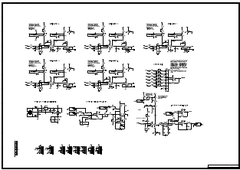 Five-pole leapfrog-topology
active filter, default configuration as a near-elliptic VCF with response
peaks at DC, 0.667f, and 1f, then a very sharp slope, and response nulls at
2f and 3f, where f is the frequency chosen by control voltage. User/build manual
with schematic (PDF); source package
including PCB design (ZIP); audio demos.
Five-pole leapfrog-topology
active filter, default configuration as a near-elliptic VCF with response
peaks at DC, 0.667f, and 1f, then a very sharp slope, and response nulls at
2f and 3f, where f is the frequency chosen by control voltage. User/build manual
with schematic (PDF); source package
including PCB design (ZIP); audio demos.
See kits and assembled modules in our shop.
MSK 008 Dual VC Octave Switch
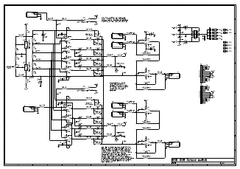 This module can add an octave switch function
to an oscillator or other device that doesn't have one built in, but it also
does several other things. Two channels in an 8HP module. Each channel
contains an octave-level quantizer (that is: it rounds input to the nearest
whole volt between -2 and +2), a precision adder, and a three-position
toggle switch. Flip the switch manually to add or subtract an octave from
your pitch control voltage; feed a control voltage into the quantization
input for automatic octave switching; or use two control voltages with the
adder for transposition. Each channel can also be configured by PCB solder
jumper to subtract instead of adding; the default configuration does this
with one of the two. User/build manual
with schematic (PDF); source package
including PCB design (ZIP); audio demos.
This module can add an octave switch function
to an oscillator or other device that doesn't have one built in, but it also
does several other things. Two channels in an 8HP module. Each channel
contains an octave-level quantizer (that is: it rounds input to the nearest
whole volt between -2 and +2), a precision adder, and a three-position
toggle switch. Flip the switch manually to add or subtract an octave from
your pitch control voltage; feed a control voltage into the quantization
input for automatic octave switching; or use two control voltages with the
adder for transposition. Each channel can also be configured by PCB solder
jumper to subtract instead of adding; the default configuration does this
with one of the two. User/build manual
with schematic (PDF); source package
including PCB design (ZIP); audio demos.
See kits and assembled modules in our shop.
MSK 009 "Coiler" multimode filter
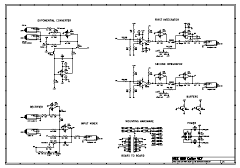 Classic OTA-based two-pole
state-variable multimode filter (low-pass, band-pass, and high-pass outputs
from a single input) with a twist: instead of only using voltage on
capacitors to represent the state variables, it uses current through
inductors at high frequencies, shading into voltage on capacitors in the
bass range. There is also a full-wave rectified input, which can be used
for distortion or as an envelope follower. User/build manual
with schematic (PDF); source package
including PCB design (ZIP); audio demos.
Classic OTA-based two-pole
state-variable multimode filter (low-pass, band-pass, and high-pass outputs
from a single input) with a twist: instead of only using voltage on
capacitors to represent the state variables, it uses current through
inductors at high frequencies, shading into voltage on capacitors in the
bass range. There is also a full-wave rectified input, which can be used
for distortion or as an envelope follower. User/build manual
with schematic (PDF); source package
including PCB design (ZIP); audio demos.
See kits and assembled modules in our shop.
MSK 010 Fixed Sine Bank
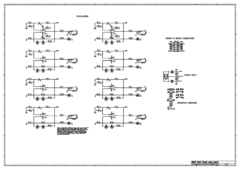 Eight fixed-frequency sine LFOs. Two big
advantages over conventional LFO designs: the sine wave are pure, coming
from sine-core oscillators without the glitches of waveshaping; and there
are eight of them, independent of each other. Having many smooth
independent LFOs is critical to large drone patches, modulating Clouds and
other complex effects, and so on; and it couldn't be done in the analog
realm with the more complex circuitry and HP consumption of
variable-frequency LFOs. User/build manual
with schematic (PDF); source package
including PCB design (ZIP); audio demos.
Eight fixed-frequency sine LFOs. Two big
advantages over conventional LFO designs: the sine wave are pure, coming
from sine-core oscillators without the glitches of waveshaping; and there
are eight of them, independent of each other. Having many smooth
independent LFOs is critical to large drone patches, modulating Clouds and
other complex effects, and so on; and it couldn't be done in the analog
realm with the more complex circuitry and HP consumption of
variable-frequency LFOs. User/build manual
with schematic (PDF); source package
including PCB design (ZIP); audio demos.
See kits and assembled modules in our shop.
MSK 011 Transistor Mixer
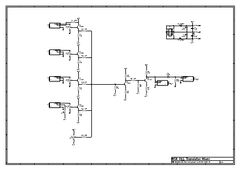 Minimalist four-knob utility
mixer, for audio or control voltages. Just six discrete transistors in
traditional Class A circuits. AC and DC coupled outputs. Can be used as a
distortion unit by offsetting the signal into the clipping region. User/build manual
with schematic (PDF); source package
including PCB design (ZIP); audio demos.
Minimalist four-knob utility
mixer, for audio or control voltages. Just six discrete transistors in
traditional Class A circuits. AC and DC coupled outputs. Can be used as a
distortion unit by offsetting the signal into the clipping region. User/build manual
with schematic (PDF); source package
including PCB design (ZIP); audio demos.
See kits and assembled modules in our shop.
MSK 012 Transistor ADSR
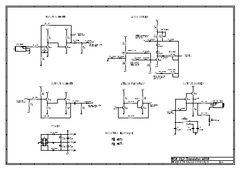 An ADSR envelope generator built from
discrete transistors - no op amps or other ICs! Nice simple
multivibrator-based design, with a Schmitt trigger on the input allowing it
to trigger from slowly changing voltages without needing a sharp edge. User/build manual
with schematic (PDF); source package
including PCB design (ZIP); audio demos.
An ADSR envelope generator built from
discrete transistors - no op amps or other ICs! Nice simple
multivibrator-based design, with a Schmitt trigger on the input allowing it
to trigger from slowly changing voltages without needing a sharp edge. User/build manual
with schematic (PDF); source package
including PCB design (ZIP); audio demos.
See kits and assembled modules in our shop.
MSK 013 Middle Path VCO
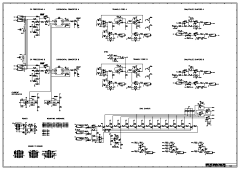 A "complex VCO" suited for both East
Coast and West Coast synthesis styles. Two triangle cores, sync, and sine
shaper. The exponential converter uses analog multipliers and a premium
transistor array to give accurate tracking and temperature stability with a
minimum of fiddly adjustment. The sine shaper is a modification of the
Gilbert design with three output, two of which are a quadrature pair; it
allows for a wide range of distortion, through-zero, fake stereo, and
wavefolding effects. User/build manual
with schematic (PDF); source package
including PCB design (ZIP); audio demos.
A "complex VCO" suited for both East
Coast and West Coast synthesis styles. Two triangle cores, sync, and sine
shaper. The exponential converter uses analog multipliers and a premium
transistor array to give accurate tracking and temperature stability with a
minimum of fiddly adjustment. The sine shaper is a modification of the
Gilbert design with three output, two of which are a quadrature pair; it
allows for a wide range of distortion, through-zero, fake stereo, and
wavefolding effects. User/build manual
with schematic (PDF); source package
including PCB design (ZIP); audio demos.
See kits and assembled modules in our shop.
MSK 014 Gracious Host
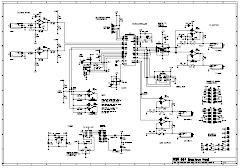 North Coast's first digital module: a
USB-MIDI to CV/gate interface with a variety of monophonic, polyphonic,
arpeggiation, and quantization modes. This is a host, not a
device, in USB terms - meaning that it can drive USB devices like MIDI
controllers without needing a separate computer. As well as USB-MIDI
controllers, it can host a typing (QWERTY) keyboard or a mouse; and it can
reload its own firmware from a USB mass storage device (flash drive, etc.)
for updates and customization. Based on a PIC24F microcontroller.
User/build
(hardware) manual
with schematic (PDF); Programmer's
(software) manual (PDF); source package
including PCB design (ZIP).
North Coast's first digital module: a
USB-MIDI to CV/gate interface with a variety of monophonic, polyphonic,
arpeggiation, and quantization modes. This is a host, not a
device, in USB terms - meaning that it can drive USB devices like MIDI
controllers without needing a separate computer. As well as USB-MIDI
controllers, it can host a typing (QWERTY) keyboard or a mouse; and it can
reload its own firmware from a USB mass storage device (flash drive, etc.)
for updates and customization. Based on a PIC24F microcontroller.
User/build
(hardware) manual
with schematic (PDF); Programmer's
(software) manual (PDF); source package
including PCB design (ZIP).
See kits and assembled modules in our shop.
MSK 015 Quad VCA NEW
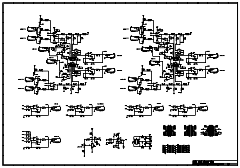 Four VCA channels based on the AS3360 VCA chip, with separate positive and
negative control voltages, and sum, difference, and global
sum outputs. Patch programmable as four separate two-quadrant VCAs; two
four-quadrant ("ring modulator") VCAs; mid/side encoder and decoder; voltage
controlled pan; crossfade; and various combinations. Accurate unity gain at
+5V unattenuated control input, above-unity gain available with higher
control voltages.
User/build
manual with schematic (PDF); source package
including PCB design (ZIP).
Four VCA channels based on the AS3360 VCA chip, with separate positive and
negative control voltages, and sum, difference, and global
sum outputs. Patch programmable as four separate two-quadrant VCAs; two
four-quadrant ("ring modulator") VCAs; mid/side encoder and decoder; voltage
controlled pan; crossfade; and various combinations. Accurate unity gain at
+5V unattenuated control input, above-unity gain available with higher
control voltages.
User/build
manual with schematic (PDF); source package
including PCB design (ZIP).
See kits and assembled modules in our shop.
Plans-only SDIY projects
Except for the passive multiples and friends, these date from before North Coast was a commercial operation, when I was just releasing free module designs for my own amusement. Be aware that they are not as polished as the commercial designs above.
Passive multiples and friends
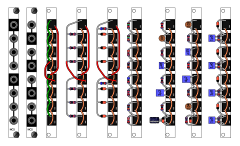 Instructions for
building passive multiples, and several other unpowered 2HP Eurorack module
projects, with a shared PCB-panel design. As well as the original "raw dog"
passive multiple, this includes instructions for a fixed passive mixer; an
OR combiner; a fixed attenuator; a low-pass filter/slew rate limiter; a
high-pass filter/DC blocker/gate to trigger converter; and an envelope
follower. Passive
multiples and friends manual (PDF); package of Gerber files for the panel PCB
design (ZIP).
Instructions for
building passive multiples, and several other unpowered 2HP Eurorack module
projects, with a shared PCB-panel design. As well as the original "raw dog"
passive multiple, this includes instructions for a fixed passive mixer; an
OR combiner; a fixed attenuator; a low-pass filter/slew rate limiter; a
high-pass filter/DC blocker/gate to trigger converter; and an envelope
follower. Passive
multiples and friends manual (PDF); package of Gerber files for the panel PCB
design (ZIP).
MSK 002 "Asuka and Shinji" Distortion Amplifier
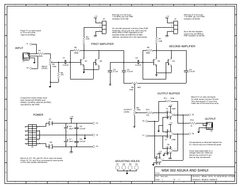 This project originated in a search for a
worthy use of some new-old-stock germanium transistors that came into my
possession. I also designed it around a pile of 0.47µF ceramic disc
capacitors I had. It's a fuzz/distortion amplifier with a topology similar
to the classic Fuzzrite guitar pedal, reworked into a Eurorack module.
Depending on the knob settings, it can do extreme clipping-type distortion,
a milder foldback similar to what tubes do, or just amplify with relatively
little distortion (useful for boosting line-level signals to modular level).
The PCB design is jumper-configurable for NPN or PNP transistors and can
even combine one of each in a single channel. Each channel uses two
transistors and there's some value in testing different individual
transistors for best sound; but they are best not matched as such,
but rather selected (the best combinations involve two transistors
that don't match). In my prototype I built two channels into an 8HP
Eurorack module and called them Asuka (the germanium PNP transistors) and
Shinji (recent NPN silicon types). User/build manual
with schematic (PDF); package containing Gerber and FPD designs for PCB and panel
(ZIP); audio demos.
This project originated in a search for a
worthy use of some new-old-stock germanium transistors that came into my
possession. I also designed it around a pile of 0.47µF ceramic disc
capacitors I had. It's a fuzz/distortion amplifier with a topology similar
to the classic Fuzzrite guitar pedal, reworked into a Eurorack module.
Depending on the knob settings, it can do extreme clipping-type distortion,
a milder foldback similar to what tubes do, or just amplify with relatively
little distortion (useful for boosting line-level signals to modular level).
The PCB design is jumper-configurable for NPN or PNP transistors and can
even combine one of each in a single channel. Each channel uses two
transistors and there's some value in testing different individual
transistors for best sound; but they are best not matched as such,
but rather selected (the best combinations involve two transistors
that don't match). In my prototype I built two channels into an 8HP
Eurorack module and called them Asuka (the germanium PNP transistors) and
Shinji (recent NPN silicon types). User/build manual
with schematic (PDF); package containing Gerber and FPD designs for PCB and panel
(ZIP); audio demos.
MSK 003 Unpowered Ring Modulator
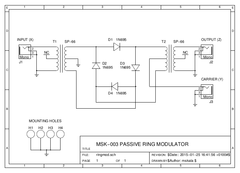 I'm now calling this an "unpowered" module
because I want to discourage people from using the term "passive" for
modules that contain active components like diodes... but the documents
still say "passive" because that's what I called it when I first released
it. Whichever term you use, the point is that it draws its power from the
input signals without needing a connection of its own to the power supply.
One of the first modules I ever designed: just a simple transformer-based
ring modulator circuit using a true ring of diodes (not a four-quadrant
multiplier made some other way) for the authentic ring modulator sound. I
built mine with hand-matched germanium diodes. Two boards fit nicely into a
4HP module; the boards (one ring modulator per board) could easily be
repurposed to other form factors too. User/build manual
with schematic (PDF); package containing Gerber and FPD designs for the
PCB and panel
(ZIP); audio demo.
I'm now calling this an "unpowered" module
because I want to discourage people from using the term "passive" for
modules that contain active components like diodes... but the documents
still say "passive" because that's what I called it when I first released
it. Whichever term you use, the point is that it draws its power from the
input signals without needing a connection of its own to the power supply.
One of the first modules I ever designed: just a simple transformer-based
ring modulator circuit using a true ring of diodes (not a four-quadrant
multiplier made some other way) for the authentic ring modulator sound. I
built mine with hand-matched germanium diodes. Two boards fit nicely into a
4HP module; the boards (one ring modulator per board) could easily be
repurposed to other form factors too. User/build manual
with schematic (PDF); package containing Gerber and FPD designs for the
PCB and panel
(ZIP); audio demo.
MSK 006 Exponential VCA
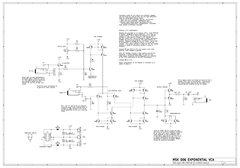 Exponential-response VCA built out of TO-92
discrete transistors (20 of them per channel!). The circuit is more or less
that of an LM13700 operational transconductance amplifier chip, build out of
single transistors for art's sake. It's not exactly hi-fi, but it imparts a
warm and sweet crackling distortion that I rather like. It also provides a
fair bit of output power and could be used for tasks like driving headphones
or small speakers directly. User/build manual
with schematic (PDF); source package
including PCB design (ZIP); audio demo.
Exponential-response VCA built out of TO-92
discrete transistors (20 of them per channel!). The circuit is more or less
that of an LM13700 operational transconductance amplifier chip, build out of
single transistors for art's sake. It's not exactly hi-fi, but it imparts a
warm and sweet crackling distortion that I rather like. It also provides a
fair bit of output power and could be used for tasks like driving headphones
or small speakers directly. User/build manual
with schematic (PDF); source package
including PCB design (ZIP); audio demo.
Other DIY modules, past and future
Not every module I build actually makes it to the level of a project I can share. Some are plans for the future; others represent experiments from the past. Here are a few from those two categories.
MSK 001 "Sekai" Universal Host
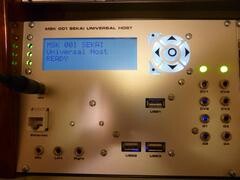 Single-board ARM Linux
machine, USB hub, two CVpals, and a LCD/pushbutton module all combined
behind a 36HP panel. I use this for controlling my Eurorack, with a
USB-MIDI keyboard, by SSHing into it over the Ethernet connection, and with
homemade control software running directly on the module (including a
program specifically for exploring fractal
chord progressions). Unfortunately, it's a one-off and pretty much
stuck as a one-off because it was designed around components I can't get in
quantity. This particular single-board computer is no longer made, the USB
hub I used was a cheapo no-name brand one with some tricky modifications,
and so on. Also, the Sekai requires massive amounts of +5V power, delivered
by a separate wall-wart power supply that plugs into the front panel.
Single-board ARM Linux
machine, USB hub, two CVpals, and a LCD/pushbutton module all combined
behind a 36HP panel. I use this for controlling my Eurorack, with a
USB-MIDI keyboard, by SSHing into it over the Ethernet connection, and with
homemade control software running directly on the module (including a
program specifically for exploring fractal
chord progressions). Unfortunately, it's a one-off and pretty much
stuck as a one-off because it was designed around components I can't get in
quantity. This particular single-board computer is no longer made, the USB
hub I used was a cheapo no-name brand one with some tricky modifications,
and so on. Also, the Sekai requires massive amounts of +5V power, delivered
by a separate wall-wart power supply that plugs into the front panel.
MSK 004 "Octothorpe" Octuple VCO
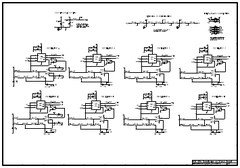 Eight VCO cores sharing a common control system.
They have independent outputs but they're meant to be used as a single unit,
for chorus and cloud effects, with adjustable detuning and some extra
features, including an adjustable-coefficient temperature compensation
system. The oscillator cores are based on 555 timers, but they're sawtooth
cores, not similar to the Thomas Henry 555 triangle VCO core. Lots of neat
ideas in here, but overall, there were enough issues with it that I decided
not to proceed further after the first prototype. The biggest thing was
that the cores tend to synchronize, I think through crosstalk in the TL074
quad op amp chips, and that screws up some of the desired musical effects.
The adjustable-coefficient tempco worked well but required a complicated and
impractical adjustment procedure, warming and cooling the module to
different temperatures to explore the adjustment curve. I still like the
overall concept of a "super-saw" VCO, though, and may explore that further
in the future.
Eight VCO cores sharing a common control system.
They have independent outputs but they're meant to be used as a single unit,
for chorus and cloud effects, with adjustable detuning and some extra
features, including an adjustable-coefficient temperature compensation
system. The oscillator cores are based on 555 timers, but they're sawtooth
cores, not similar to the Thomas Henry 555 triangle VCO core. Lots of neat
ideas in here, but overall, there were enough issues with it that I decided
not to proceed further after the first prototype. The biggest thing was
that the cores tend to synchronize, I think through crosstalk in the TL074
quad op amp chips, and that screws up some of the desired musical effects.
The adjustable-coefficient tempco worked well but required a complicated and
impractical adjustment procedure, warming and cooling the module to
different temperatures to explore the adjustment curve. I still like the
overall concept of a "super-saw" VCO, though, and may explore that further
in the future.
MSK 005 "Snake Pit"
 So called because it's
full of adders. Three channels, each containing a precision adder and a
manual slew rate limiter, plus some voltage references. After building this
and playing with it for a while, I decided not to take the design further.
The precision adder part is nice, and the idea of combining those with other
functions ended up in the MSK 008 Octave Switch, but the slew rate limiters didn't
turn out as I had hoped (in particular, they were meant to be linear and
behaved more like RC circuits) and there were some issues with the physical
design.
So called because it's
full of adders. Three channels, each containing a precision adder and a
manual slew rate limiter, plus some voltage references. After building this
and playing with it for a while, I decided not to take the design further.
The precision adder part is nice, and the idea of combining those with other
functions ended up in the MSK 008 Octave Switch, but the slew rate limiters didn't
turn out as I had hoped (in particular, they were meant to be linear and
behaved more like RC circuits) and there were some issues with the physical
design.